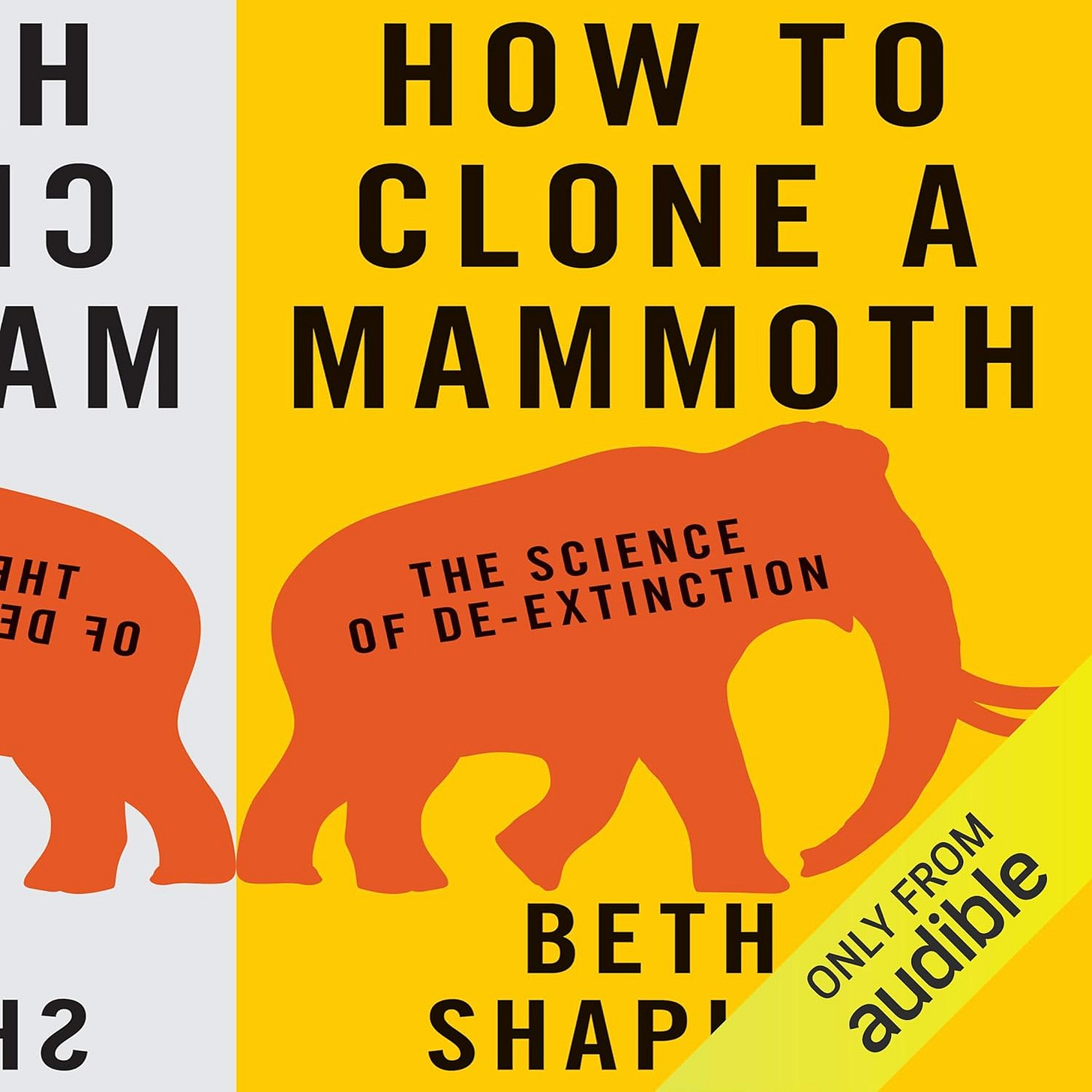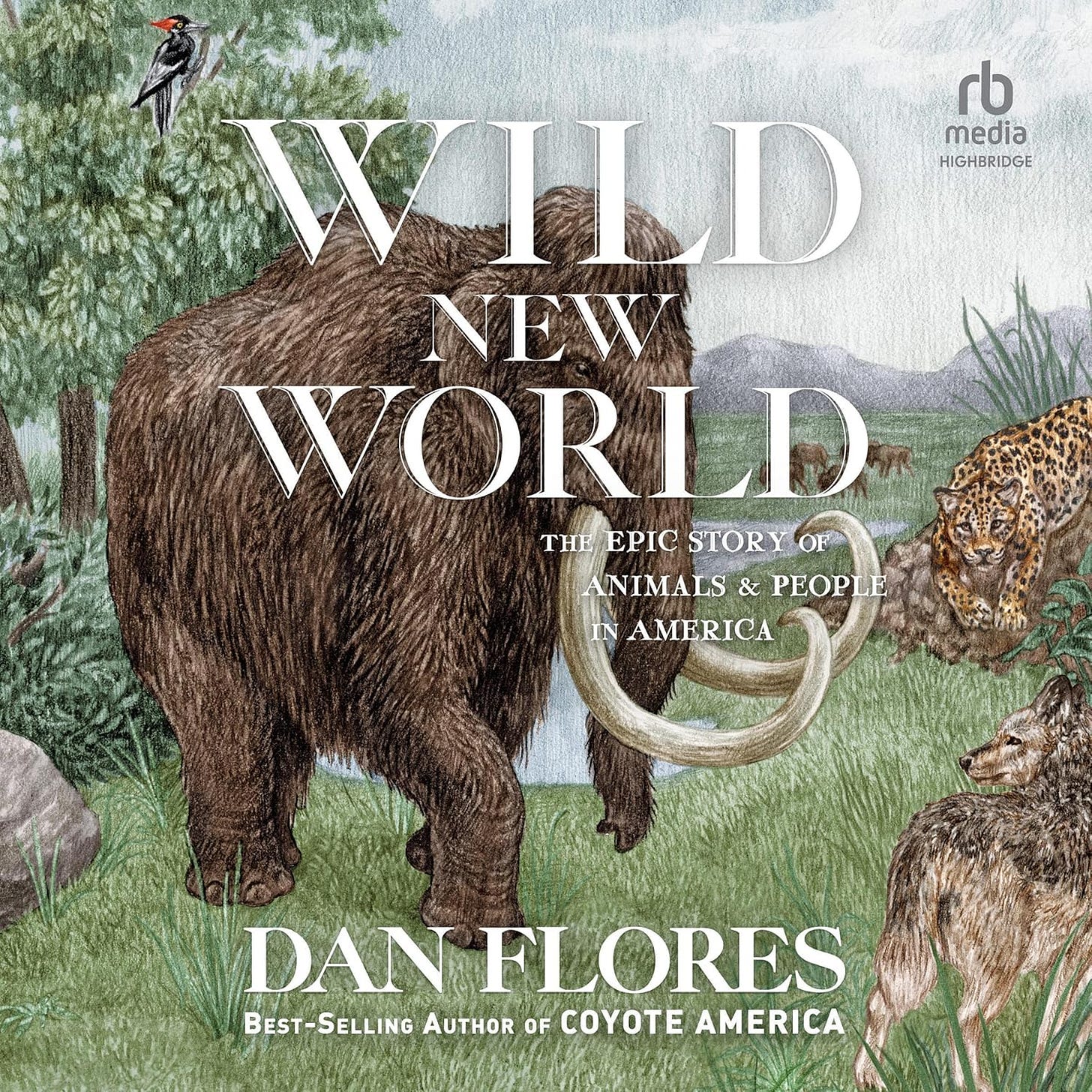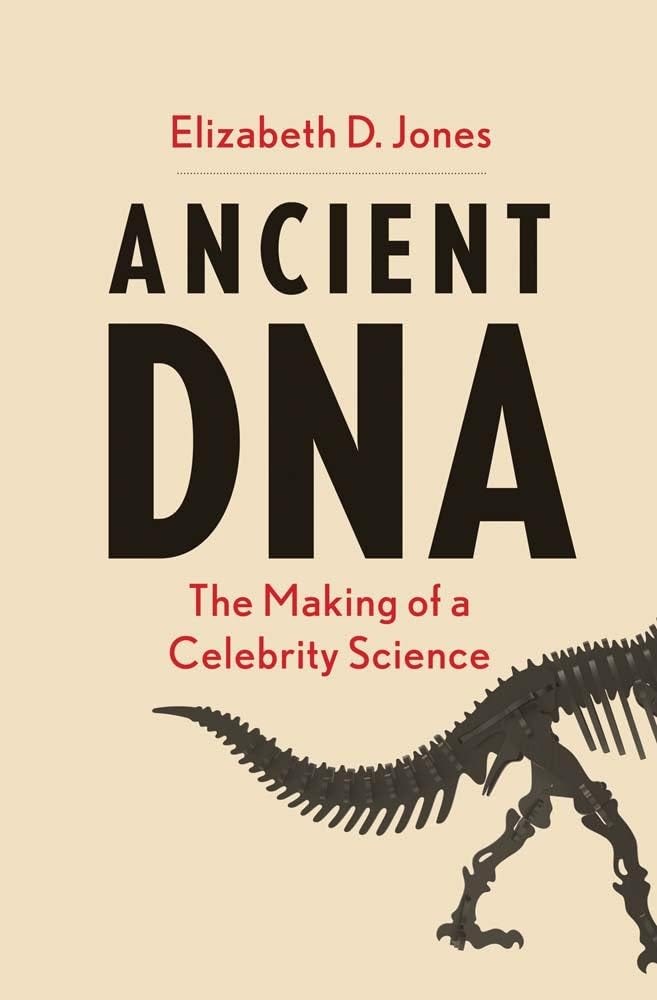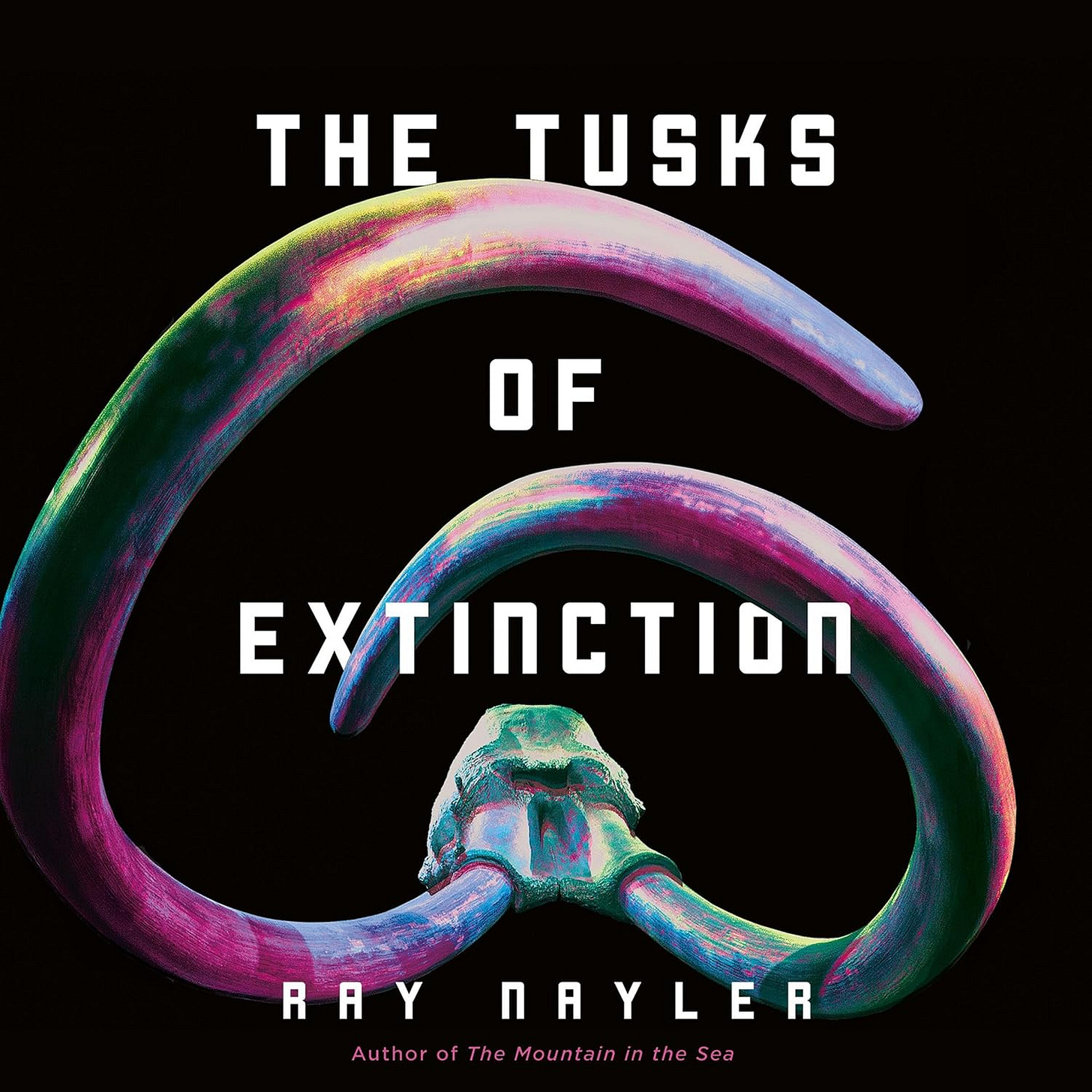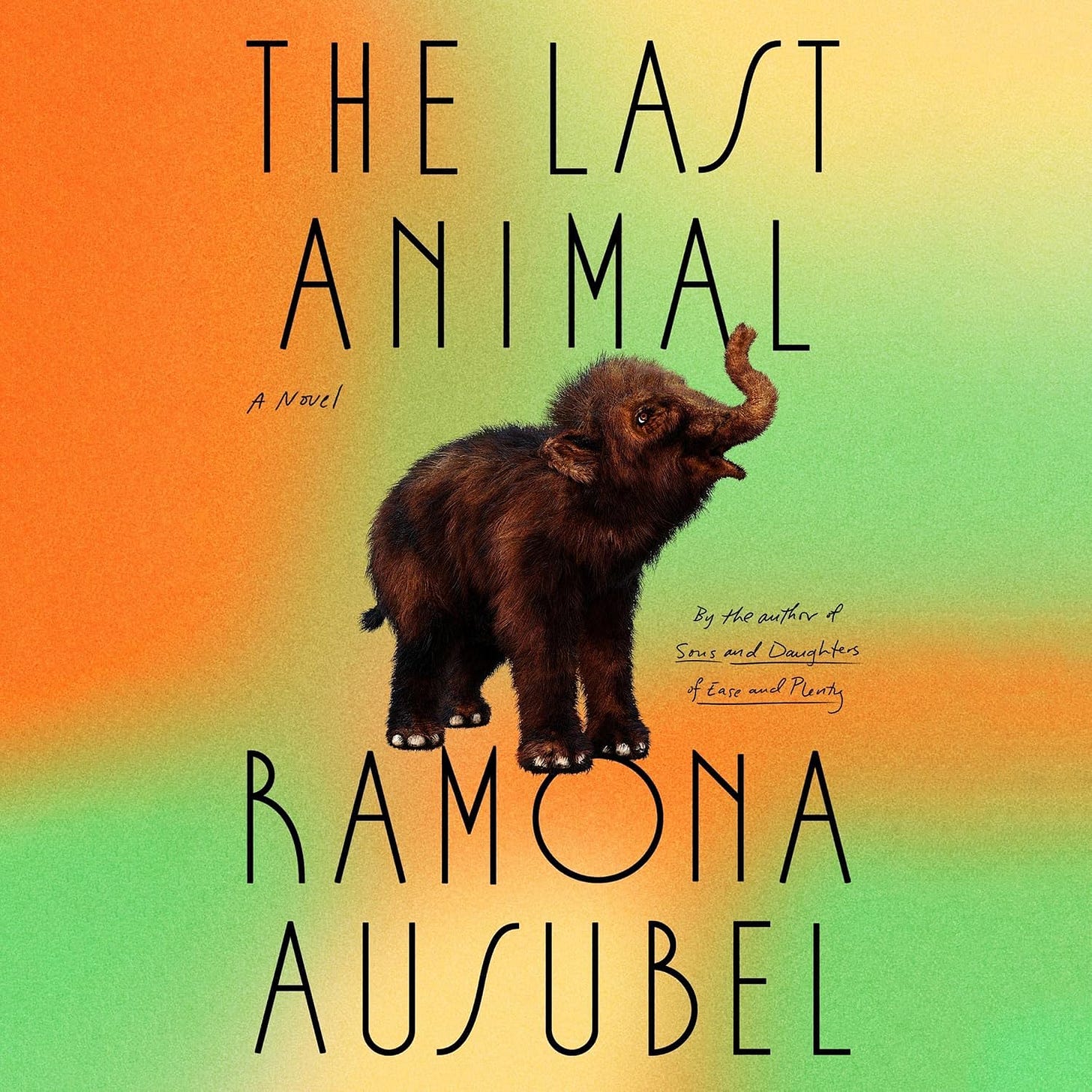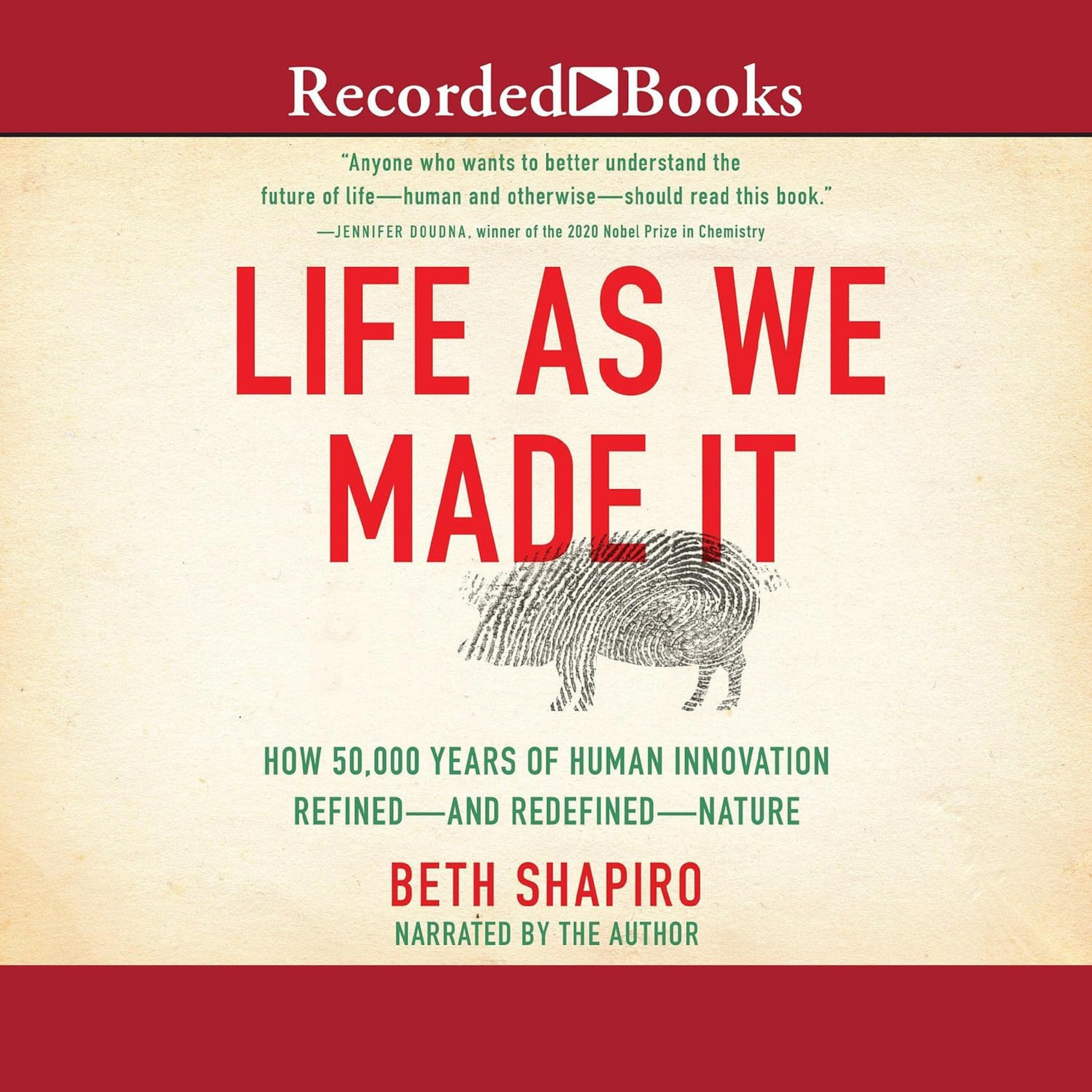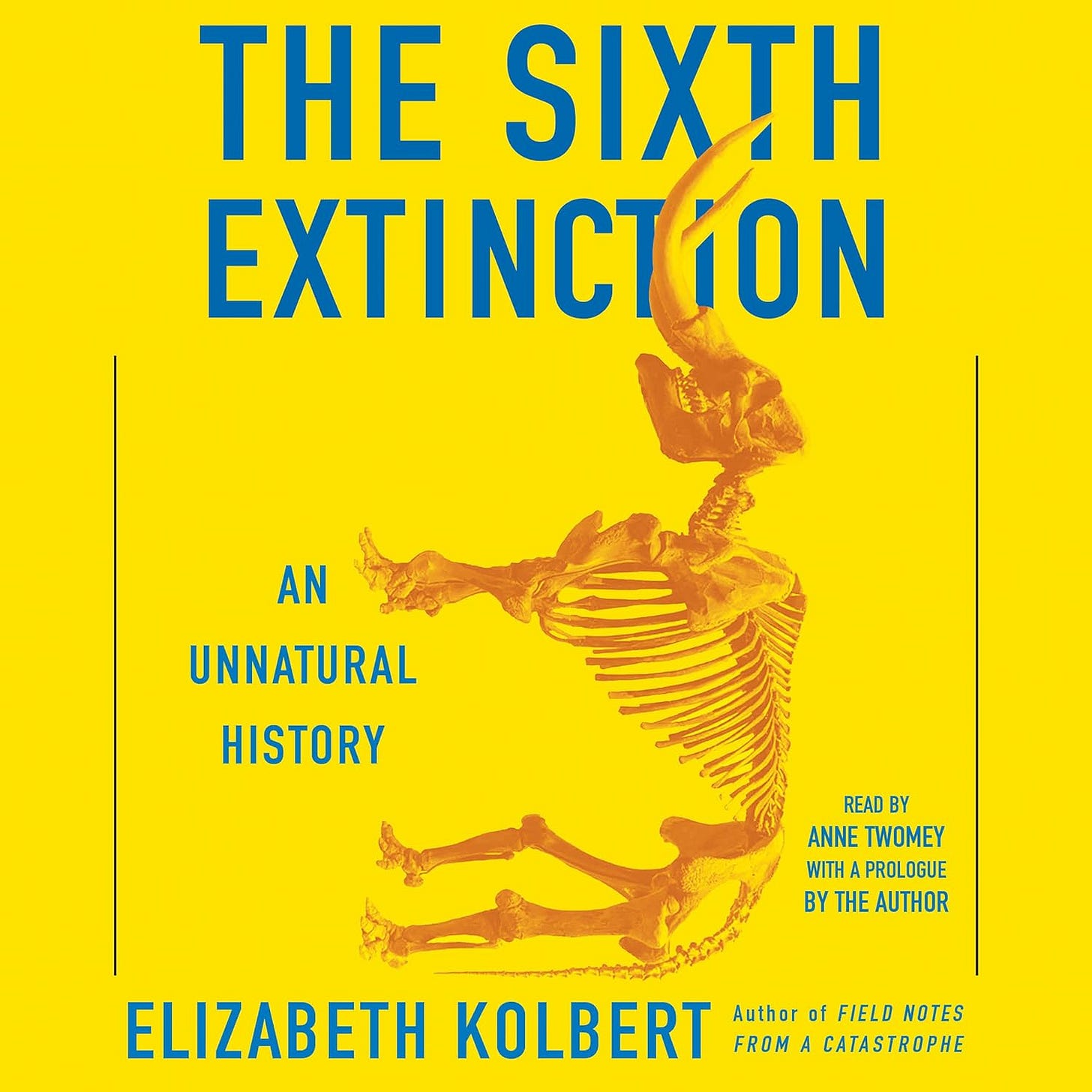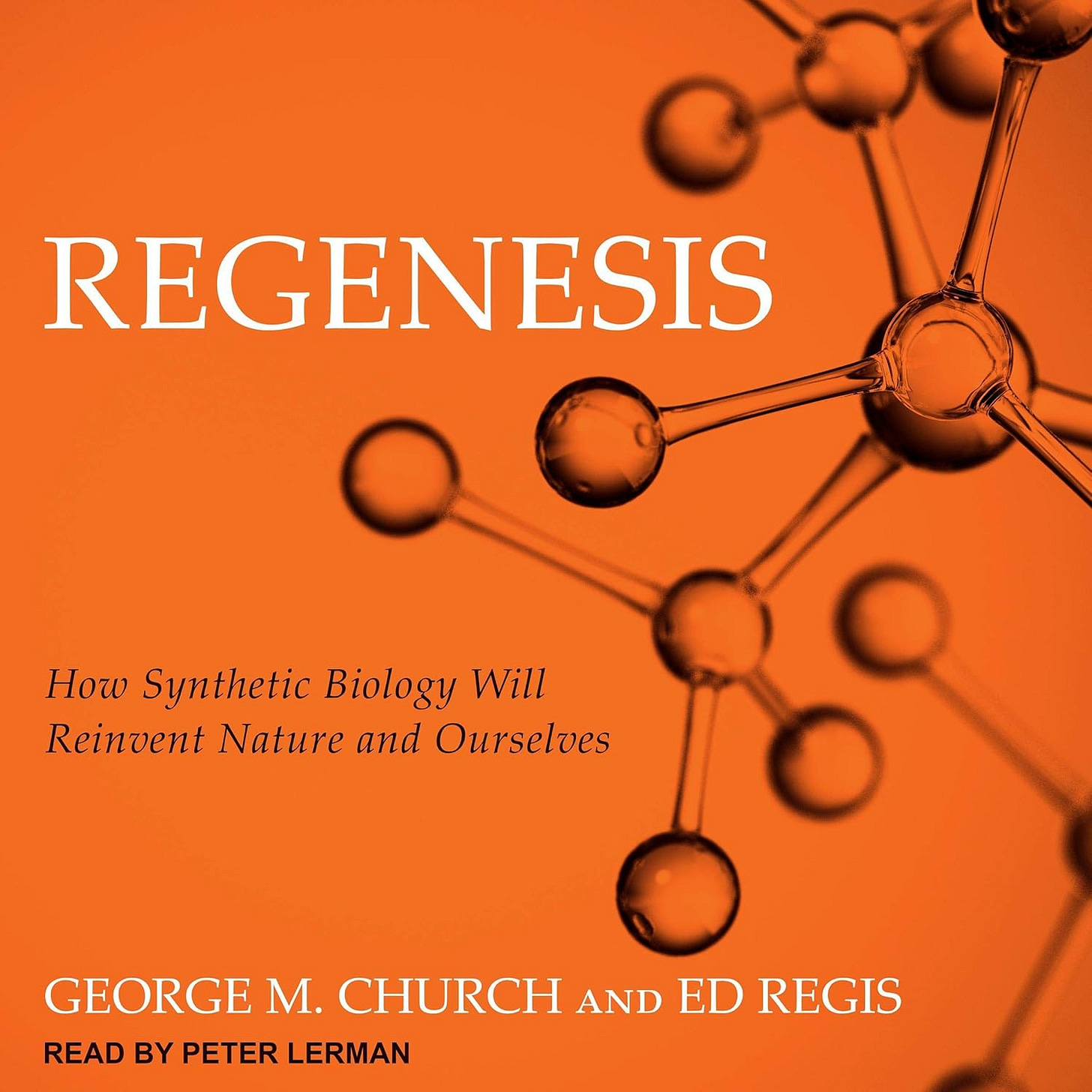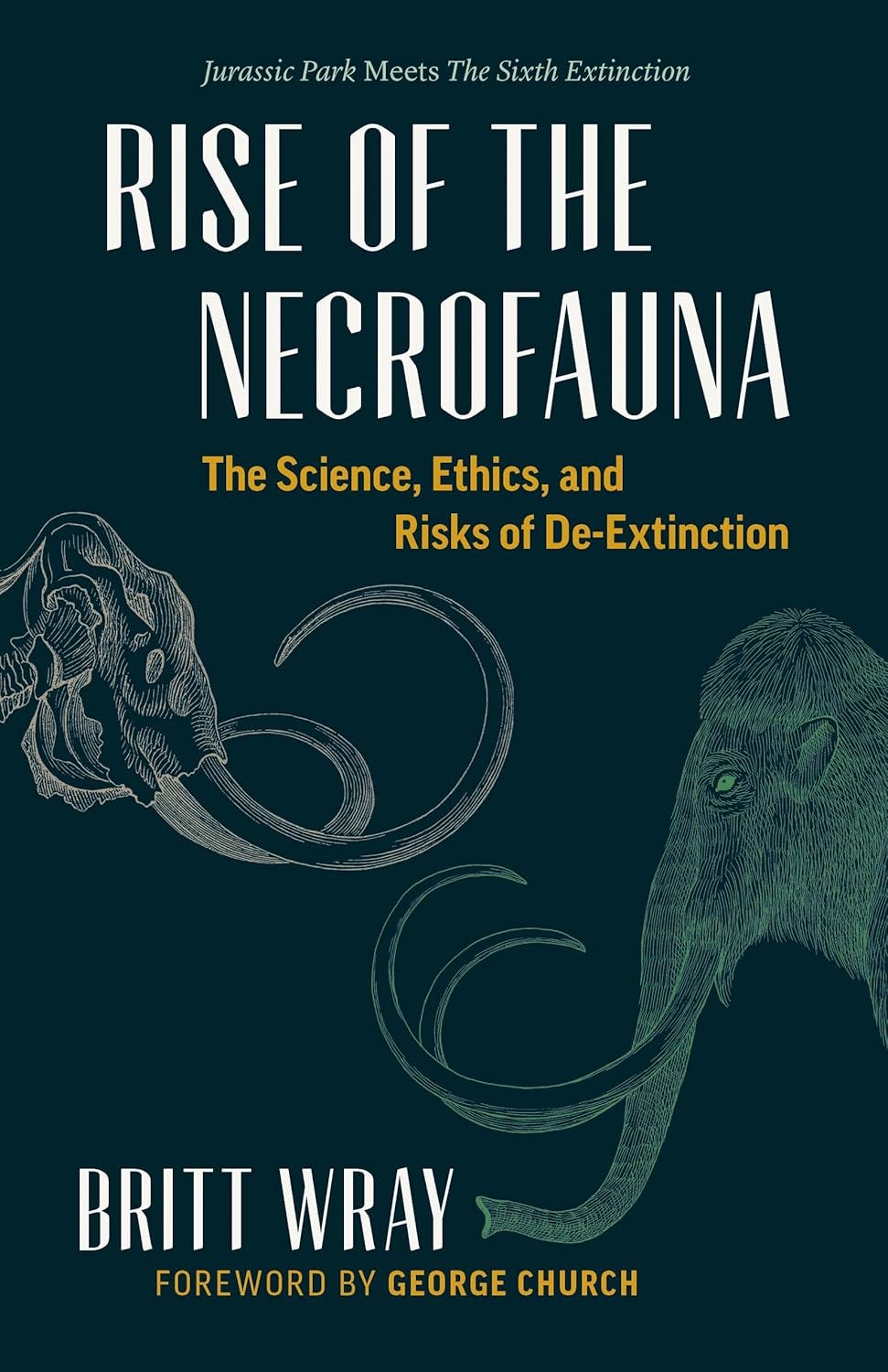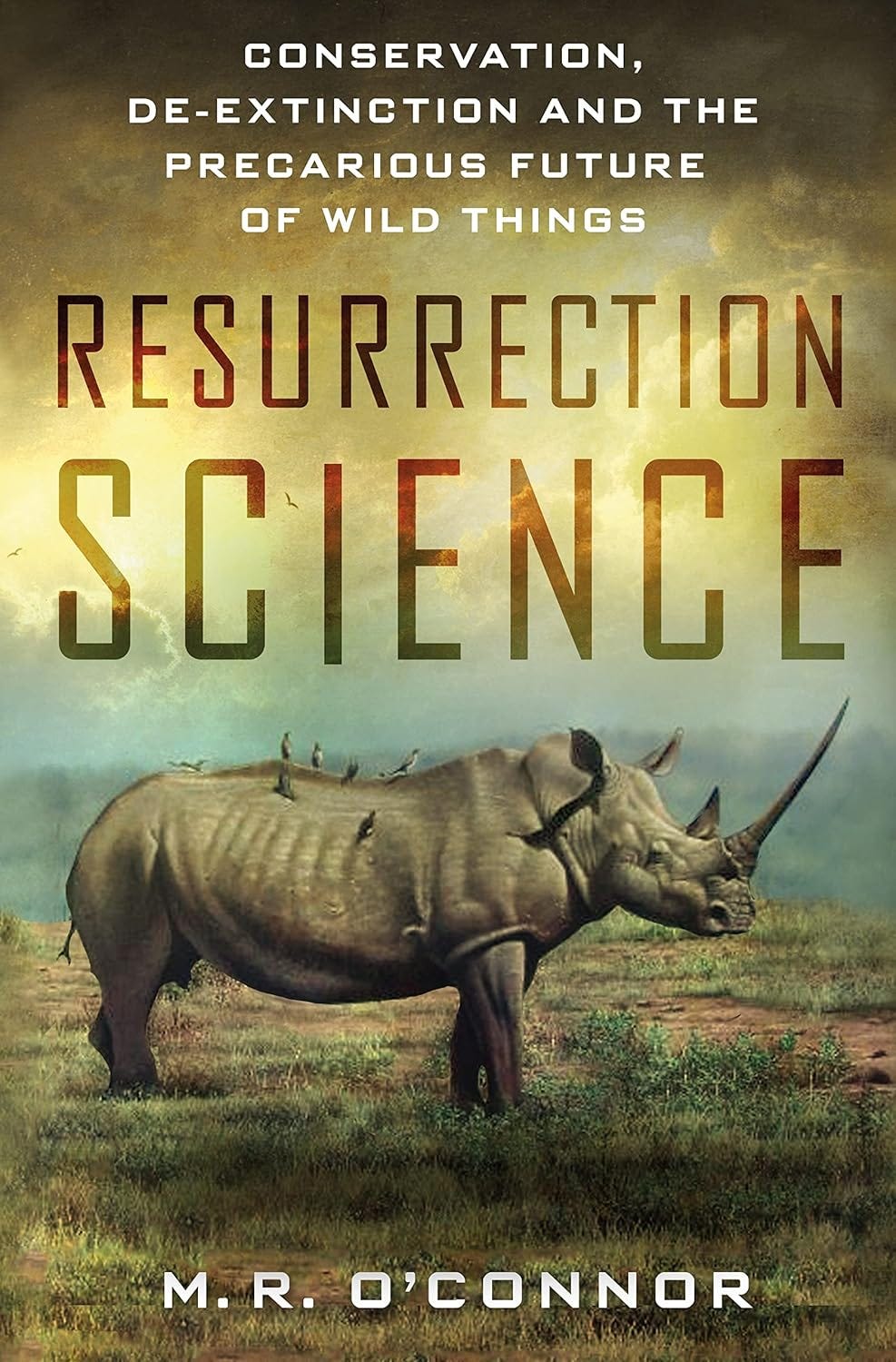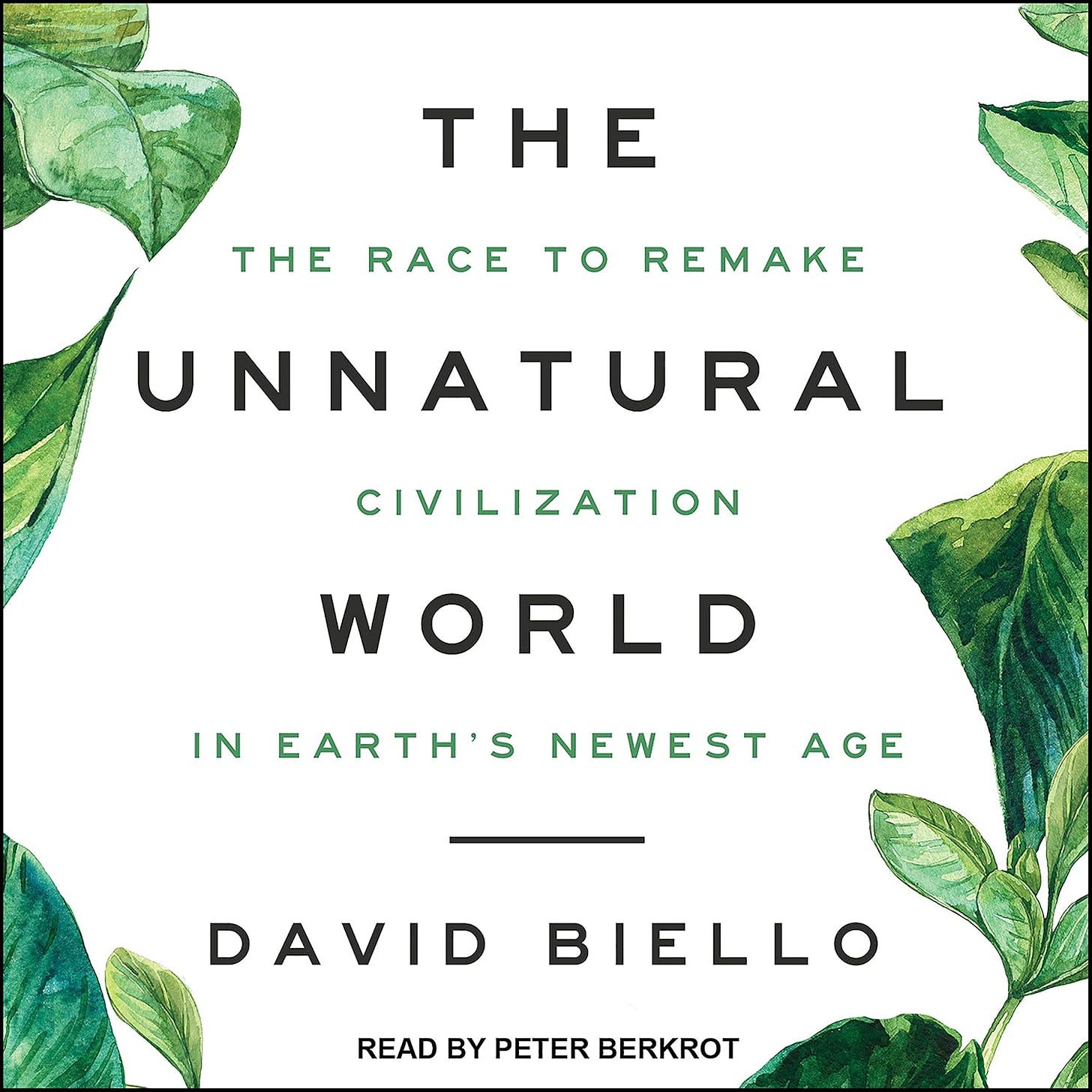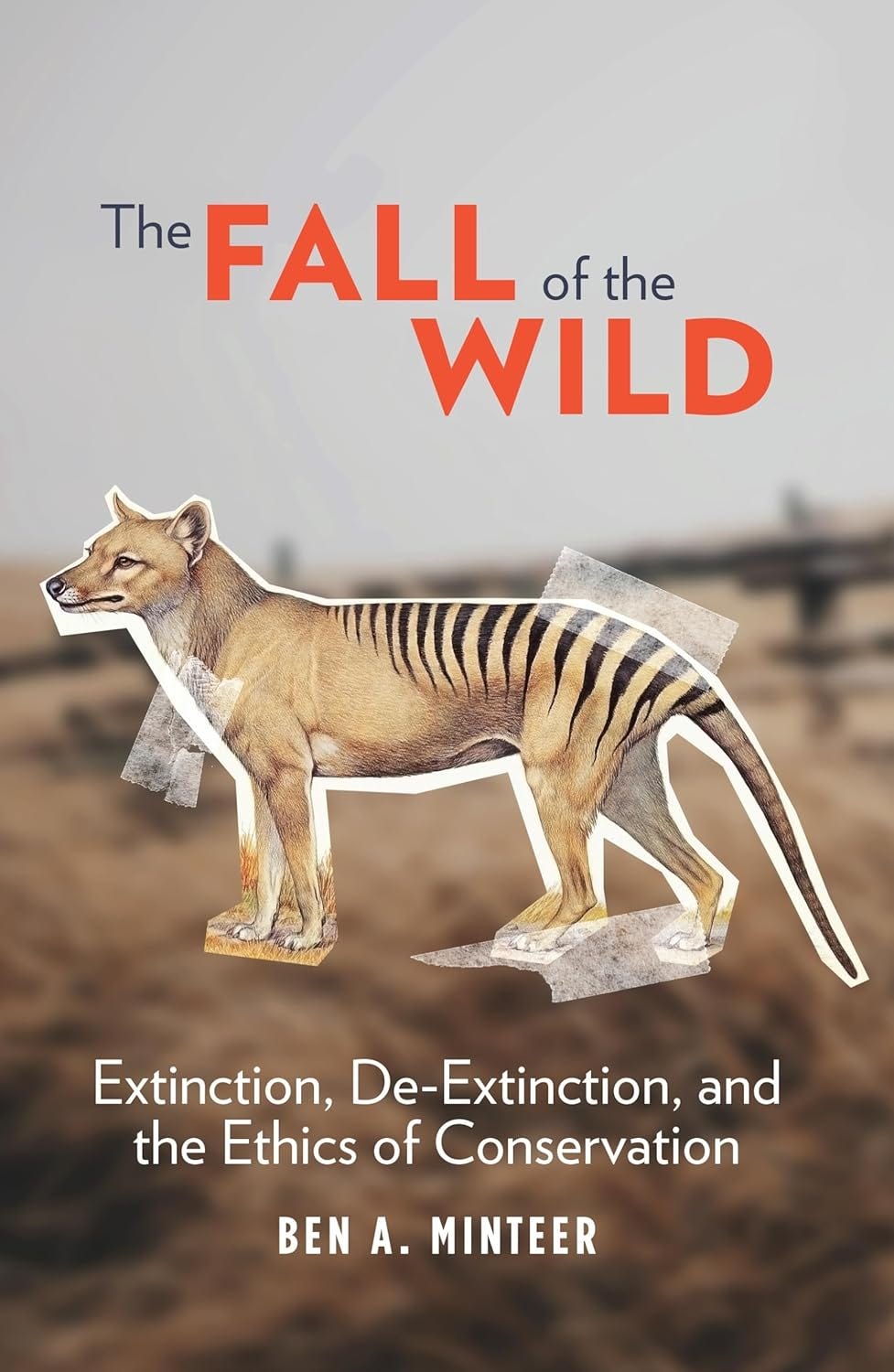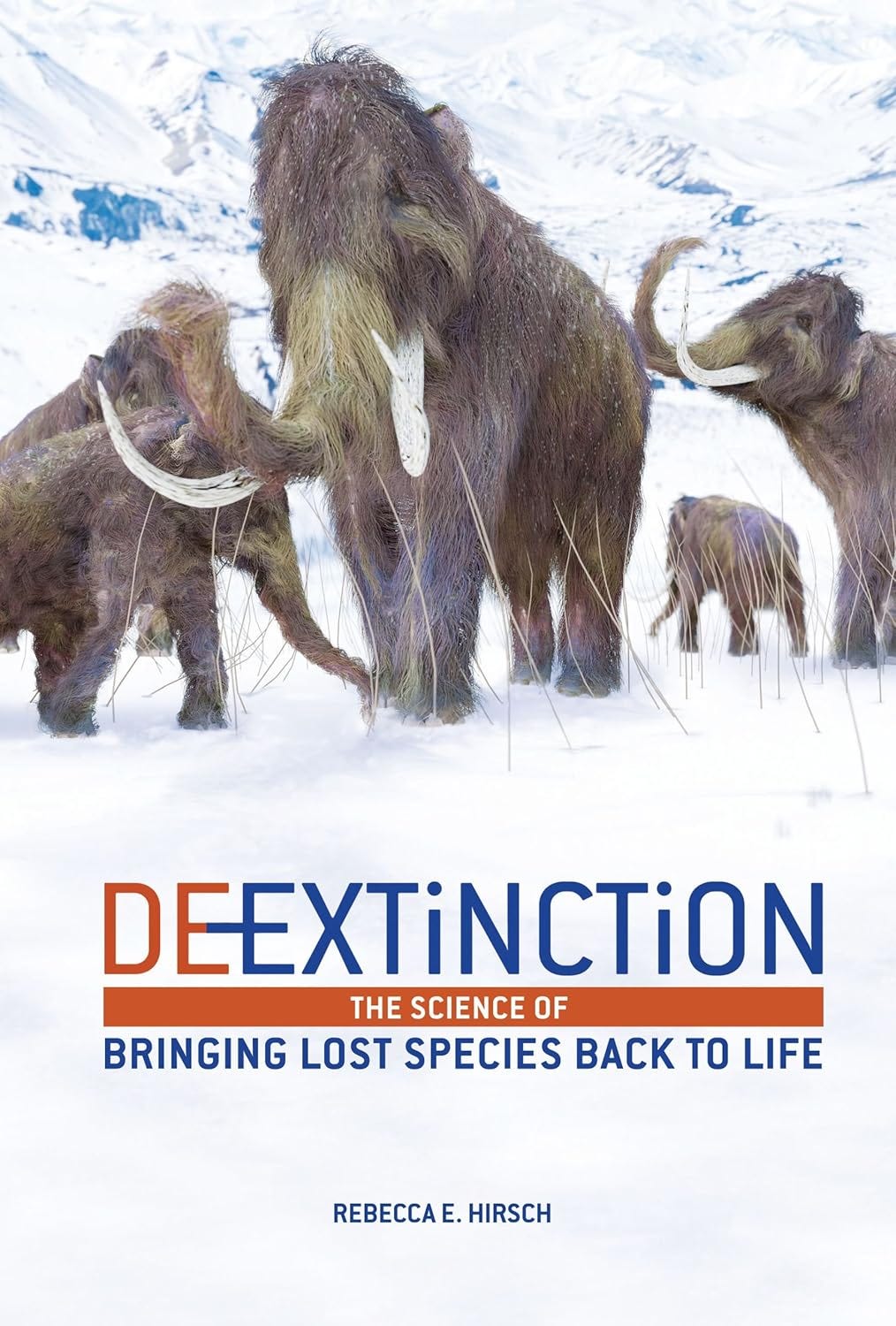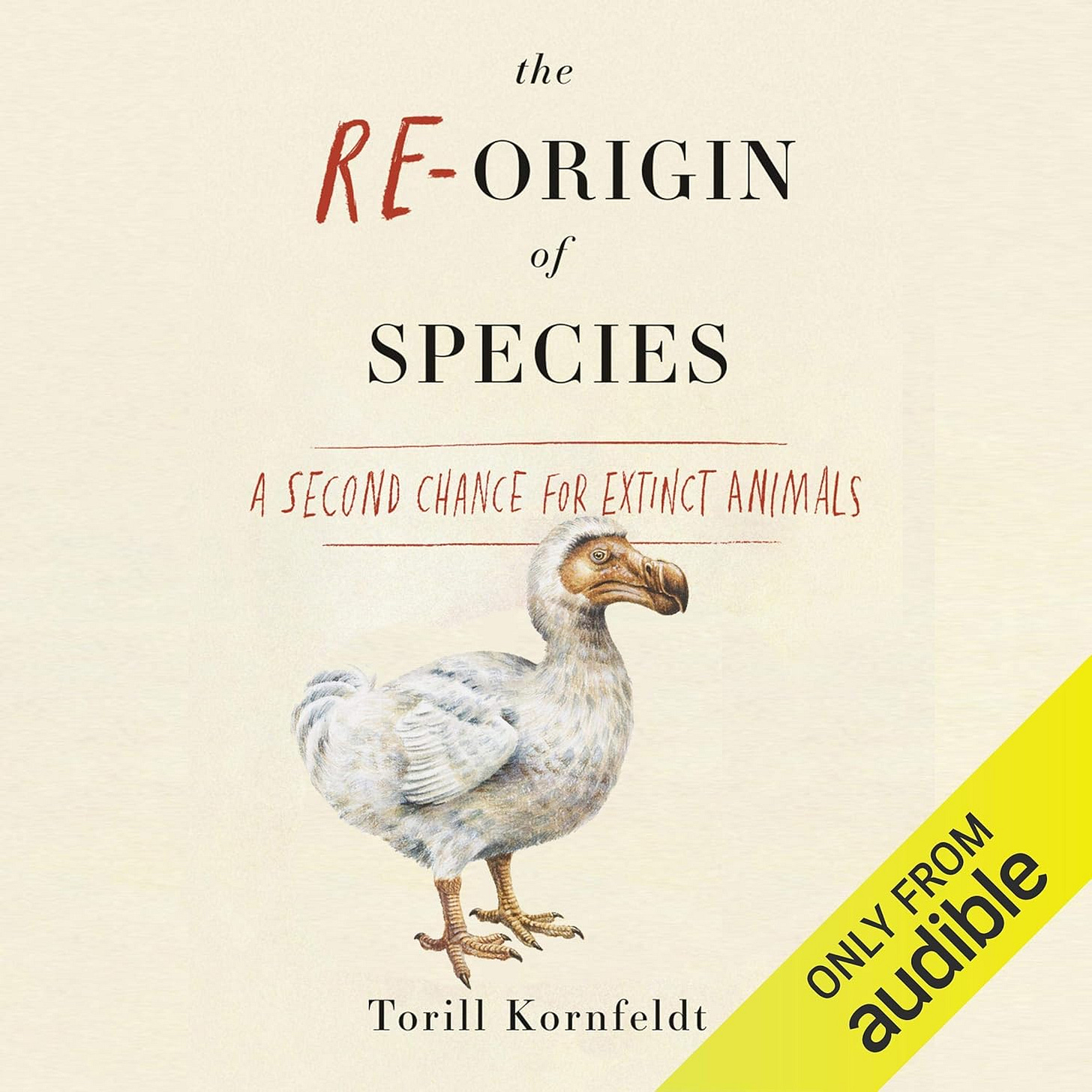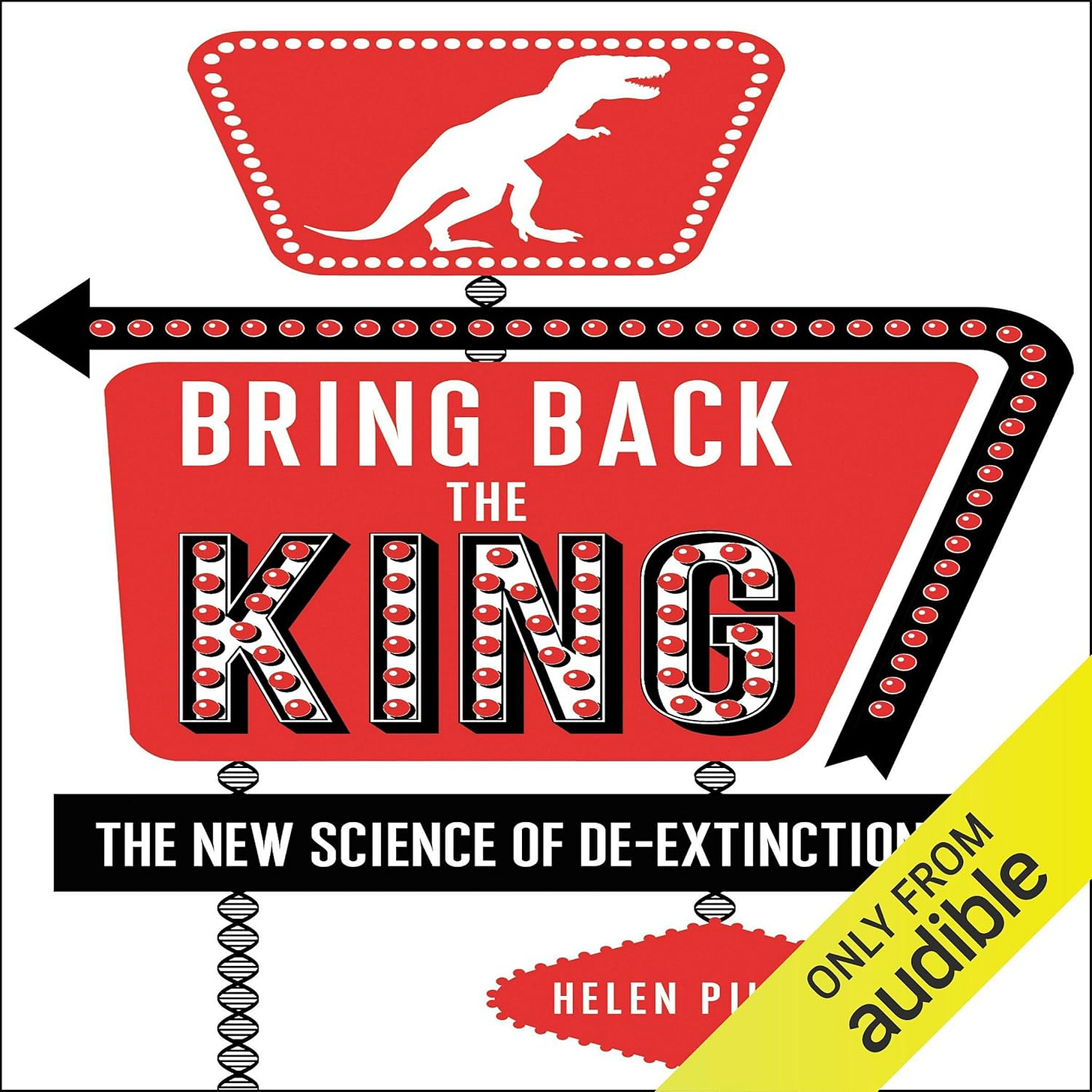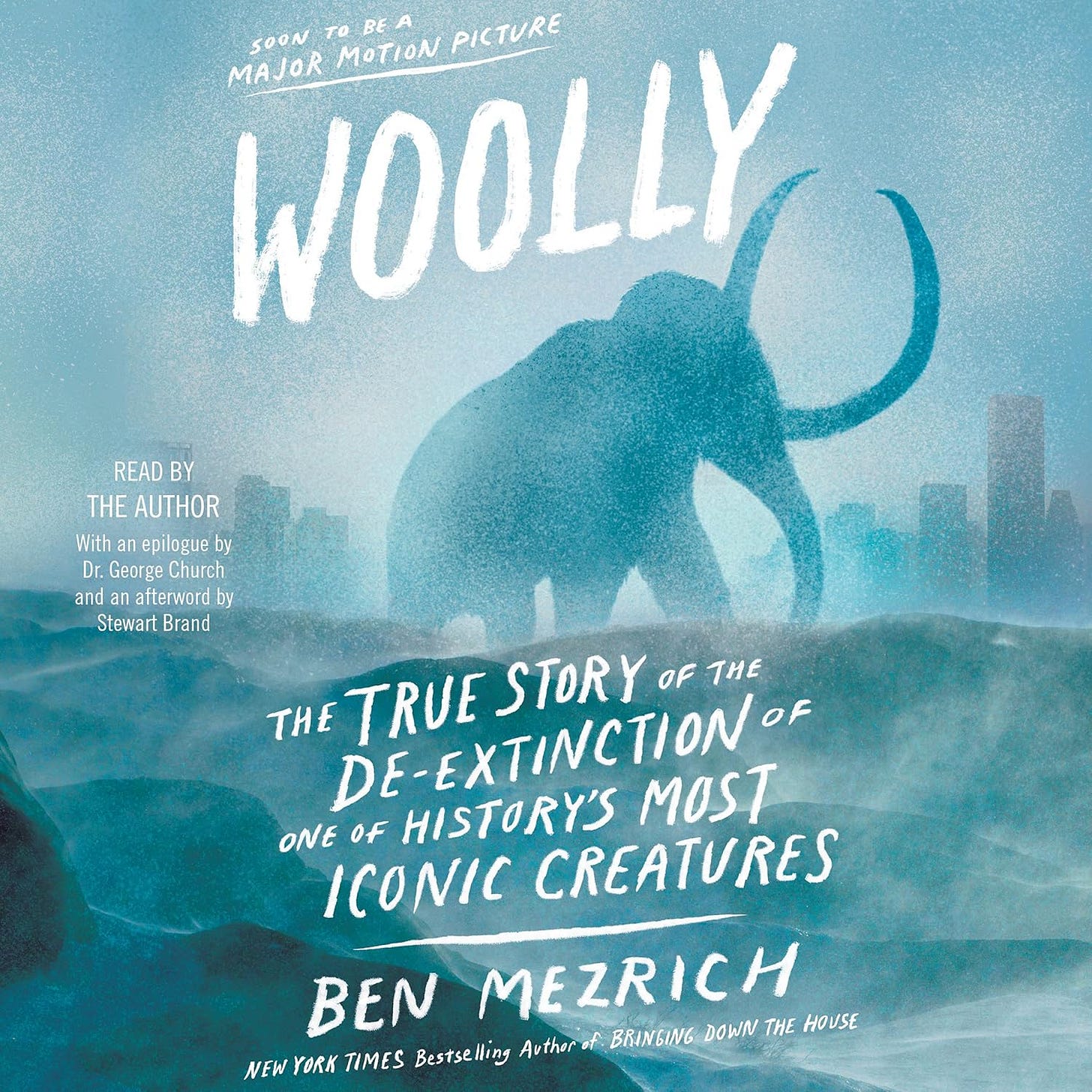What I'm reading: de-extinction edition
Something a little different this week: book recommendations! De-extinction is a common theme across a few of the fiction and nonfiction books I read this year.
The Baader–Meinhof phenomenon (aka the frequency illusion) is the name for that thing that happens when you buy a new car, and suddenly you notice that same model car everywhere you drive. It’s a cognitive bias where you notice a specific concept, word, or product more frequently after recently becoming aware of it.
I joined Colossal Biosciences almost two years ago.1 When I learned what the company was attempting to do, and after talking to some of the brilliant scientists working here, I knew I had to be a part of it. I started noticing how de-extinction had already entered the pop culture through literature. My TBR pile never gets any shorter, and there were several books on my shelf already (fiction and nonfiction) that had themes of de-extinction, either as the focus or as an ancillary device. Here are a few I read this year.
When I write here about what I’m reading (usually research papers) I get to the point quickly: what a paper showed, how they did it, and what resources they made available along the way. Cautious of avoiding any potential spoilers, I’ll keep these reviews and recommendations short.
Nonfiction
How to Clone a Mammoth: The Science of De-Extinction, by Beth Shapiro
This one is required reading for anyone interested in de-extinction. How to Clone a Mammoth was published in 2015, which means that the author (Beth Shapiro, Colossal’s chief scientist and my boss!) had probably completed most of the writing 10 years ago. Despite its age, it still holds up. CRISPR technology for genome engineering has matured a ton over the last decade (see Wang and Doudna’s recent review on CRISPR technology), but the tech isn’t the focus of the book. One of the central theses of the book is that de-extinction will proceed in two phases. The first phase includes everything up to the birth of a living organism. This part is hard, but may not be the hardest. The second phase involves everything that comes after that — the production, rearing, release, and management of unextinct populations in the wild. This phase is arguably harder! Some of the fiction books below speculate on this phase of de-extinction — how, for instance, will a newly unextinct mammoth calf learn to be a mammoth?
Wild New World: The Epic Story of Animals and People in America, by Dan Flores
I loved this book. The vivid imagery of a prehistoric North America teeming with megafauna that Dan conjures in these pages will stick with you for a long time. Dan Flores is a member of Colossal’s Conservation Advisory Board, and Professor Emeritus of Western History at the University of Montana-Missoula. I had the privilege to meet Dan when he visited Colossal and gave a talk on conservation, and I immediately bought this book and his previous book, Coyote America. This book is exceptionally well-researched and describes with vivid imagery past epochs where humans and animals co-existed in North America, including woolly mammoths, Columbian mammoths, flightless sea ducks, great auks, heath hens, bison, pronghorns, beavers, sea otters, fur seals, bald eagles, hummingbirds, whooping cranes, snowy egrets, trumpeter swans, peregrine falcons, California condors, jaguars, cougars, alligators, rattlesnakes, gray wolves, red wolves, Mexican wolves, eastern wolves, grizzly bears, wild horses, prairie dogs, black-footed ferrets, coyotes, spotted owls, ivory-billed woodpeckers, and of course, passenger pigeons. The book is also a tragedy — the arrival of humans in North America resulted in senseless slaughter and intentional extermination of these animals, from the widely known passenger pigeons, buffalo, and wolves, to the lesser known animals such as the Carolina parakeet and the great auk. This is such a beautiful book and I can’t recommend it strongly enough.
Ancient DNA: The Making of a Celebrity Science, by Elizabeth Jones
This book chronicles the rise of the “celebrity science” of ancient DNA research. I never knew that the hypothesis that DNA from dinosaurs could survive in insects entombed in amber arose before the publication and filming of Jurassic Park (spoiler alert: DNA from dinosaurs is not preserved in amber). This is another well-researched book citing scientific and historical data and interviews with dozens of ancient DNA researchers worldwide. Side note: the author was a postdoc at NC State when she wrote this book. I wish I could have been half as productive as a postdoc!
Fiction
Extinction, by Douglas Preston
Literary fiction this is not — it’s a page-turner suspense thriller beach read reminiscent of Michael Crichton. The setting is a luxurious resort in the Colorado Rockies that has brought back woolly mammoths, megatheria (giant ground sloths), Irish elk, Castoroides (giant beavers), and the woolly indricothere (a hornless rhino as tall as a giraffe, one of the largest terrestrial mammals to have ever walked the earth). Things go wrong, bodies turn up, and we find out what the scientists at this resort have really been up to.
The Tusks of Extinction, by Ray Nayler
De-extinction doesn’t end when the first healthy animal is born. Like many social animals, elephant behavior (and, presumably mammoth behavior) is learned from elephant (and mammoth) ancestors. This book starts with the successful resurrection of the woolly mammoth, but these mammoths have to learn how to behave like a mammoth and survive like a mammoth. To do so, the scientists find the Kurzweil-like digitized consciousness upload of an expert in elephant behavior who died defending elephants from ivory poachers, and upload this consciousness into the mind of a de-extincted mammoth matriarch. Solid sci-fi, but short (the audiobook is only ~4 hours).
The Last Animal, by Ramona Ausubel
This story starts off on a scientific expedition in Siberia where the daughters of a single mother scientist discover a perfectly preserved baby mammoth. Skipping ahead, several characters make a plan to impregnate an elephant with a genetically modified embryo based on the mammoth’s DNA. This book is less about the mammoth and de-extinction and more a story about family, relationships, grief, love, and loss.
TBR
I have a few other biodiversity / de-extinction adjacent books on my To Be Read pile. All nonfiction.
Life as We Made It, by Beth Shapiro
I have this one queued on Audible. For nonfiction I almost always prefer hearing the text read in the author’s voice, and Beth narrates the audiobook. From the book jacket:
In 2020, the inventors of CRISPR, the revolutionary gene-editing tool, won the Nobel Prize for medicine. It seemed like the capstone of an astounding 50-year run: We have turned bacteria into factories for insulin, used viruses to insert genes for pesticide resistance into plants, and now learned to rewrite our own DNA.
Once, we humans could only observe evolution. Suddenly, we had conquered it. And yet, in Life as We Made It, evolutionary biologist Beth Shapiro argues that - despite how amazing our new technologies are - our ability to alter the course of evolution isn’t new. Humans have been reshaping the world around us for ages, from the first dogs to genetically modified Enviropigs. Indeed, she argues, resetting the course of evolution is what our species does, by domesticating, as with dogs and wheat; by hunting, as with wolves and mammoths; and by protecting, as with bison and mountain lions.
What is new is that where once we shaped evolution through brute force, we can now do it as artisans. That power comes not a moment too soon. If we are going to survive in the next few centuries, we must revise the book of life. Instead of rehashing arguments about genetic engineering, let’s embrace the fact that we can shape evolution to create a world in which we want to live. The question isn’t should we meddle, but how? Life as We Made It is an essential book for charting a better course into a risky future.
The Sixth Extinction, by Elizabeth Kolbert
Last year I read Kolbert’s newer book, Under a White Sky: The Nature of the Future, and really enjoyed it. I’m looking forward to reading this one. This book won the Pulitzer prize, along with several other awards, and there’s even a young readers adaptation that was published earlier this year. From the book jacket:
Over the last half a billion years, there have been five mass extinctions, when the diversity of life on earth suddenly and dramatically contracted. Scientists around the world are currently monitoring the sixth extinction, predicted to be the most devastating extinction event since the asteroid impact that wiped out the dinosaurs. This time around, the cataclysm is us.
In The Sixth Extinction, two-time winner of the National Magazine Award and New Yorker writer Elizabeth Kolbert draws on the work of scores of researchers in half a dozen disciplines, accompanying many of them into the field: geologists who study deep ocean cores, botanists who follow the tree line as it climbs up the Andes, marine biologists who dive off the Great Barrier Reef. She introduces us to a dozen species, some already gone, others facing extinction, including the Panamian golden frog, staghorn coral, the great auk, and the Sumatran rhino.
Through these stories, Kolbert provides a moving account of the disappearances occurring all around us and traces the evolution of extinction as concept, from its first articulation by Georges Cuvier in revolutionary Paris up through the present day. The sixth extinction is likely to be mankind's most lasting legacy; as Kolbert observes, it compels us to rethink the fundamental question of what it means to be human.
Coyote America, by Dan Flores
Dan’s Wild New World was one one of my favorite books I read this year. Coyote America came out a few years ago, and I’m looking forward to reading this one. From the book jacket:
With its uncanny night howls, unrivaled ingenuity, and amazing resilience, the coyote is the stuff of legends. In Indian folktales it often appears as a deceptive trickster or a sly genius. But legends don't come close to capturing the incredible survival story of the coyote.
As soon as Americans - especially white Americans - began ranching and herding in the West, they began working to destroy the coyote. Despite campaigns of annihilation employing poisons, gases, helicopters, and engineered epidemics, coyotes didn't just survive, they thrived, expanding across the continent from Anchorage, Alaska, to New York's Central Park. In the war between humans and coyotes, coyotes have won hands down.
Coyote America is both an environmental and a deep natural history of the coyote. It traces both the five-million-year-long biological story of an animal that has become the "wolf" in our backyards and its cultural evolution from a preeminent spot in Native American religions to the hapless foil of the Road Runner. A deeply American tale, the story of the coyote in the American West and beyond is a sort of Manifest Destiny in reverse, with a pioneering hero whose career holds up an uncanny mirror to the successes and failures of American expansionism.
An illuminating biography of this extraordinary animal, Coyote America isn't just the story of an animal's survival - it is one of the great epics of our time.
Regenesis, by George Church
George Church needs no introduction. The book is a bit dated, but a book on synthetic biology from one of Colossal’s cofounders deserves a place on my TBR list. From the Regenesis book jacket:
A Harvard biologist and master inventor explores how new biotechnologies will enable us to bring species back from the dead, unlock vast supplies of renewable energy, and extend human life. In Regenesis, George Church and science writer Ed Regis explore the possibilities of the emerging field of synthetic biology. Synthetic biology, in which living organisms are selectively altered by modifying substantial portions of their genomes, allows for the creation of entirely new species of organisms. These technologies-far from the out-of-control nightmare depicted in science fiction-have the power to improve human and animal health, increase our intelligence, enhance our memory, and even extend our life span. A breathtaking look at the potential of this world-changing technology, Regenesis is nothing less than a guide to the future of life.
Rise of the Necrofauna: The Science, Ethics, and Risks of De-Extinction, by Britt Wray
This book has a forward from George Church. And, the tagline, “Jurassic Park meets The Sixth Extinction” mentions another book on my TBR list, The Sixth Extinction, noted above. From the book jacket:
What happens when you try to recreate a woolly mammoth—fascinating science, or conservation catastrophe? Jurassic Park meets The Sixth Extinction in Rise of the Necrofauna, a provocative look at de-extinction from acclaimed documentarist and science writer Britt Wray, PhD.
In Rise of the Necrofauna, Wray takes us deep into the minds and labs of some of the world’s most progressive thinkers to find out. She introduces us to renowned futurists like Stewart Brand and scientists like George Church, who are harnessing the powers of CRISPR gene editing in the hopes of “reviving” extinct passenger pigeons, woolly mammoths, and heath hens. She speaks with Nikita Zimov, who together with his eclectic father Sergey, is creating Siberia’s Pleistocene Park—a daring attempt to rebuild the mammoth’s ancient ecosystem in order to save earth from climate disaster. Through interviews with these and other thought leaders, Wray reveals the many incredible opportunities for research and conservation made possible by this emerging new field.
But we also hear from more cautionary voices, like those of researcher and award-winning author Beth Shapiro (How to Clone a Woolly Mammoth) and environmental philosopher Thomas van Dooren. Writing with passion and perspective, Wray delves into the larger questions that come with this incredible new science, reminding us that de-extinction could bring just as many dangers as it does possibilities. What happens, for example, when we bring an “unextinct” creature back into the wild? How can we care for these strange animals and ensure their comfort and safety—not to mention our own? And what does de-extinction mean for those species that are currently endangered? Is it really ethical to bring back an extinct passenger pigeon, for example, when countless other birds today will face the same fate?
By unpacking the many biological, technological, ethical, environmental, and legal questions raised by this fascinating new field, Wray offers a captivating look at the best and worst of resurrection science.
Resurrection Science: Conservation, De-Extinction and the Precarious Future of Wild Things, by M. R. O’Connor
From the book jacket:
In a world dominated by people and rapid climate change, species large and small are increasingly vulnerable to extinction. In Resurrection Science, journalist M. R. O'Connor explores the extreme measures scientists are taking to try and save them, from captive breeding and genetic management to de-extinction. Paradoxically, the more we intervene to save species, the less wild they often become. In stories of sixteenth-century galleon excavations, panther-tracking in Florida swamps, ancient African rainforests, Neanderthal tool-making, and cryogenic DNA banks, O'Connor investigates the philosophical questions of an age in which we "play god" with earth's biodiversity.
Each chapter in this beautifully written book focuses on a unique species--from the charismatic northern white rhinoceros to the infamous passenger pigeon--and the people entwined in the animals' fates. Incorporating natural history and evolutionary biology with conversations with eminent ethicists, O'Connor's narrative goes to the heart of the human enterprise: What should we preserve of wilderness as we hurtle toward a future in which technology is present in nearly every aspect of our lives? How can we co-exist with species when our existence and their survival appear to be pitted against one another?
The Unnatural World: The Race to Remake Civilization in Earth's Newest Age, by David Biello
From the book jacket:
The Unnatural World chronicles a disparate band of unlikely heroes: an effervescent mad scientist who would fertilize the seas, a pigeon obsessive bent on bringing back the extinct; a low-level government functionary in China doing his best to clean up his city, and more. These scientists, billionaires, and ordinary people are all working toward saving the best home humanity is likely to ever have.
What is the threat? It is us. In a time when a species dies out every 10 minutes, when summers are getting hotter, winters colder, and oceans higher, some people still deny mankind's effect on the Earth. But all of our impacts on the planet have ushered in what qualifies as a new geologic epoch, thanks to global warming, mass extinction, and such technologies as nuclear weapons and plastics. The Unnatural World examines the world we have created and analyzes the glimmers of hope emerging from the efforts of incredible individuals seeking to change our future. Instead of a world without us, this history of the future shows how to become good gardeners, helping people thrive along with an abundance of plants, animals, and all the exuberant profusion of life on Earth - a better world with us.
The Fall of the Wild: Extinction, De-Extinction, and the Ethics of Conservation, by Ben A. Minteer
From the book jacket (which features a lovely Thylacine rendition):
The passenger pigeon, the great auk, the Tasmanian tiger―the memory of these vanished species haunts the fight against extinction. Seeking to save other creatures from their fate in an age of accelerating biodiversity loss, wildlife advocates have become captivated by a narrative of heroic conservation efforts. A range of technological and policy strategies, from the traditional, such as regulations and refuges, to the novel―the scientific wizardry of genetic engineering and synthetic biology―seemingly promise solutions to the extinction crisis.
In The Fall of the Wild, Ben A. Minteer calls for reflection on the ethical dilemmas of species loss and recovery in an increasingly human-driven world. He asks an unsettling but necessary question: Might our well-meaning efforts to save and restore wildlife pose a threat to the ideal of preserving a world that isn’t completely under the human thumb? Minteer probes the tension between our impulse to do whatever it takes and the risk of pursuing strategies that undermine our broader commitment to the preservation of wildness. From collecting wildlife specimens for museums and the wilderness aspirations of zoos to visions of “assisted colonization” of new habitats and high-tech attempts to revive long-extinct species, he explores the scientific and ethical concerns vexing conservation today. The Fall of the Wild is a nuanced treatment of the deeper moral issues underpinning the quest to save species on the brink of extinction and an accessible intervention in debates over the principles and practice of nature conservation.
De-Extinction: The Science of Bringing Lost Species Back to Life, by Rebecca E. Hirsch
From the mammoth-laden book jacket:
In the twenty-first century, because of climate change and other human activities, many animal species have become extinct, and many others are at risk of extinction. Once they are gone, we cannot bring them back―or can we?
With techniques such as cloning, scientists want to reverse extinction and return lost species to the wild. Some scientists want to create clones of recently extinct animals, while others want to make new hybrid animals.
Many people are opposed to de-extinction. Some critics say that the work diverts attention from efforts to save species that are endangered. Others say that de-extinction amounts to scientists "playing God." Explore the pros and cons of de-extinction and the cutting-edge science that makes it possible.
The Re-Origin of Species: a second chance for extinct animals, by Torill Kornfeldt
From the book jacket:
What does a mammoth smell like? Do dinosaurs bob their heads as they walk, like today’s birds? Do aurochs low like cows? You may soon find out.
From the Siberian permafrost to balmy California, scientists across the globe are working to resurrect all kinds of extinct animals, from ones that just left us to those that have been gone for many thousands of years. Their tools in this hunt are both fossils and cutting-edge genetic technologies. Some of these scientists are driven by sheer curiosity; others view the lost species as a powerful weapon in the fight to preserve rapidly changing ecosystems.
It seems certain that these animals will walk the earth again, but what world will that give us? And is any of this a good idea?
Science journalist Torill Kornfeldt travelled the world to meet the men and women working to bring these animals back from the dead. Along the way, she has seen the mammoth that has been frozen for 20,000 years and visited the places where these furry giants will live again.
Bring Back the King: The New Science of De-extinction, by Helen Pilcher
From the book jacket:
If you could bring back one living being from the whole of the history of time, what would you choose? Comedian and former stem-cell biologist Helen Pilcher has thought about this problem - a lot.
In Bring Back the King, Helen explains the cutting-edge science that makes the resurrection of extinct animals a very real possibility and highlights her choices from eras gone by, from the king of the dinosaurs, Tyrannosaurus rex, to the King of Rock 'n' Roll, Elvis Presley. From dinosaurs to dodos, Neanderthals to rock legends, Bring Back the King explains how the burgeoning field of DNA science is being used to help resurrect not just individual animals but entire species from their stony graves.
Funny, intriguing and informative, Bring Back the King describes current initiatives and future plans to restore deceased animals and uses both science and willful irreverence to assess how these genetic Lazaruses might fare in their brave new world. Could a pet dinosaur be trained to roll over? Would Neanderthals enjoy opera? Could a returning dodo seek vengeance upon humanity?
Blending the very latest de-extinction technology with cloning, dinosaurs with rock legends, and hard-core popular science with plenty of gags, Bring Back the King is an audiobook that you will simply have to listen to.
Woolly: The True Story of the Quest to Revive One of History's Most Iconic Extinct Creatures, by Ben Mezrich
A friend recommended this one to me. I haven’t read it, but this 2017 book sounds like an expansion on Wikipedia’s summary on Colossal’s origin story. I’m looking forward to reading this one. From the book jacket:
Science fiction becomes reality in this Jurassic Park-like story of the genetic resurrection of an extinct species - the woolly mammoth - by the best-selling author of The Accidental Billionaires and The 37th Parallel.
"With his knack for turning narrative nonfiction into stories worthy of the best thriller fiction" (Omnivoracious), Ben Mezrich takes us on an exhilarating true adventure story from the icy terrain of Siberia to the cutting-edge genetic labs of Harvard University. A group of young scientists, under the guidance of Dr. George Church, the most brilliant geneticist of our time, works to make fantasy reality by sequencing the DNA of a frozen woolly mammoth harvested from above the Arctic Circle and splicing elements of that sequence into the DNA of a modern elephant. Will they be able to turn the hybrid cells into a functional embryo and bring the extinct creatures to life in our modern world?
Along with Church and his team of Harvard scientists, a world-famous conservationist and a genius Russian scientist plan to turn a tract of the Siberian tundra into Pleistocene Park, populating the permafrost with ancient herbivores as a hedge against an environmental ticking time bomb.
More than a story of genetics, this is a thriller illuminating the race against global warming, the incredible power of modern technology, the brave fossil hunters who battle polar bears and extreme weather conditions, and the ethical quandary of cloning extinct animals. Can we right the wrongs of our ancestors who hunted the woolly mammoth to extinction - and at what cost?
The usual disclaimer applies: the views expressed in this review and every other post on this blog or related social accounts are solely my own and do not in any way reflect the opinions or positions of my employer.


